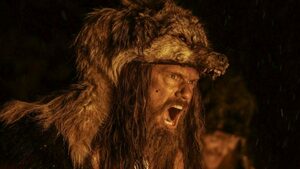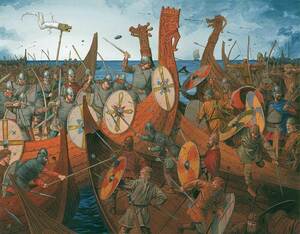From the Medieval Research Blog: "Wolves and Ravens and Bears, Oh My! The Northman and the Beasts of Battle"

Anyone who has seen The Northman knows that director Robert Eggers is interested in history and mythology. In a recent interview with Slate, he went into considerable detail about the archaeological and literary sources for many of the events and images of his latest film. Snippets of archaeological evidence from the Orkney Isles, the Osberg tapestry, and Snorri’s Edda are all woven into his story. It’s also no secret that Eggers’s films lean heavily on animal symbolism: goats and gulls are everywhere in The Vvitch and The Lighthouse. I was therefore surprised that, in his Slate interview, Eggars didn’t touch on one area that seemed ubiquitous in his latest film: the motif known in Old English scholarship as ‘the beasts of battle.’
What are the Beasts of Battle?
Simply put, the ‘beasts of battle’ are the ravens, wolves, and eagles who come to devour the slain on the battlefield. Though they are staples of early Germanic literature, their purpose remains pretty mysterious. When Arnorr Jarlaskald, the 11th century Icelandic poet, commemorated the battle of Nesjar, fought between King Olav Haraldsson and Earl Svein Hakonsson of Lade in 1016, he wrote:

Sandy corpses of [the loser] Sveinn’s men are cast from the south onto the beaches; far and wide people see where bodies float off Jutland. The wolf drags a heap of slain from the water; Olav’s son made fasting forbidden for the eagle; the wolf tears a corpse in the bays.
The beasts help themselves to the dead, and the dead are reduced to food for the beasts. In Egil’s saga, the 11th century poet Egil Skallagrimsson records that his father was a werewolf, who ripped out a man’s throat with his teeth and was nourished by the blood. Even in the complex mythology of the Vikings, carrion eaters are there to consume corpses. The wolf Fenrir, son of Loki and the giantess Angerboda, will be magically chained until Ragnarok (the Norse Doomsday), at which point he will fight and swallow Odin. His purpose is foretold in the Edda, and the very act of chaining him points towards this dark day when he will devour the dead.
This is an excerpt from "Wolves and Ravens and Bears, Oh My! The Northman and the Beasts of Battle" by Will Beattie (Ph.D. Candidate at the Medieval Institute). Read the full story.